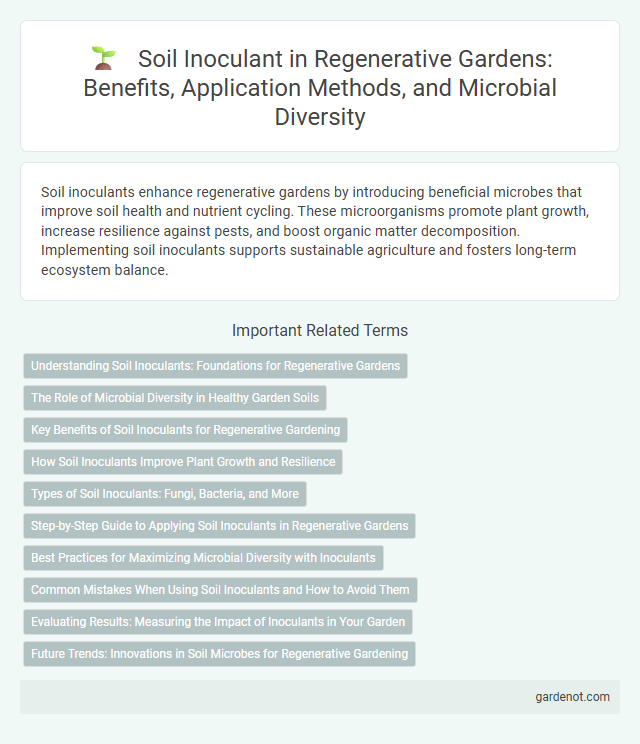Soil inoculants enhance regenerative gardens by introducing beneficial microbes that improve soil health and nutrient cycling. These microorganisms promote plant growth, increase resilience against pests, and boost organic matter decomposition. Implementing soil inoculants supports sustainable agriculture and fosters long-term ecosystem balance.
Understanding Soil Inoculants: Foundations for Regenerative Gardens
Soil inoculants contain beneficial microorganisms that enhance nutrient cycling and improve soil structure, essential for regenerative gardens. These microbial additions promote plant health by increasing nitrogen fixation, phosphorus solubilization, and disease suppression. Incorporating soil inoculants accelerates soil recovery and supports sustainable, resilient garden ecosystems.
The Role of Microbial Diversity in Healthy Garden Soils
Soil inoculants enhance garden health by introducing diverse microbial communities that improve nutrient cycling, suppress soil-borne pathogens, and promote plant growth. Microbial diversity in healthy garden soils increases resilience against diseases and environmental stress by fostering symbiotic relationships with plant roots. Incorporating beneficial bacteria, fungi, and other microorganisms supports soil structure, organic matter decomposition, and overall ecosystem function critical for regenerative gardening.
Key Benefits of Soil Inoculants for Regenerative Gardening
Soil inoculants introduce beneficial microorganisms that enhance nutrient cycling, improve soil structure, and increase plant resilience in regenerative gardening systems. By promoting symbiotic relationships between roots and microbes, these inoculants boost nitrogen fixation and phosphorus availability, leading to healthier plant growth and higher yields. Enhanced microbial diversity from soil inoculants supports long-term soil fertility and ecosystem stability, essential for sustainable regenerative garden practices.
How Soil Inoculants Improve Plant Growth and Resilience
Soil inoculants introduce beneficial microorganisms such as mycorrhizal fungi and nitrogen-fixing bacteria, enhancing nutrient availability and uptake for plants. These microorganisms improve soil structure, increase root biomass, and boost plants' resistance to diseases and environmental stressors. By accelerating nutrient cycling and promoting symbiotic relationships, soil inoculants significantly increase plant growth and resilience in regenerative gardens.
Types of Soil Inoculants: Fungi, Bacteria, and More
Soil inoculants enhance soil health by introducing beneficial microorganisms such as fungi, bacteria, and actinomycetes, each playing a unique role in nutrient cycling and plant growth promotion. Mycorrhizal fungi improve root nutrient absorption by forming symbiotic associations, while nitrogen-fixing bacteria convert atmospheric nitrogen into plant-accessible forms, boosting soil fertility naturally. Other inoculants include phosphate-solubilizing bacteria and decomposers that break down organic matter, collectively supporting a balanced, regenerative garden ecosystem.
Step-by-Step Guide to Applying Soil Inoculants in Regenerative Gardens
Applying soil inoculants in regenerative gardens enhances microbial activity and nutrient cycling, essential for soil health. Start by selecting a high-quality inoculant specific to your soil type and target plants, then prepare the soil by loosening it to improve inoculant contact. Evenly distribute the inoculant following manufacturer guidelines, incorporate it lightly into the topsoil, and maintain optimal moisture to promote colonization and maximize benefits.
Best Practices for Maximizing Microbial Diversity with Inoculants
Applying soil inoculants rich in beneficial microbes, such as mycorrhizal fungi and nitrogen-fixing bacteria, enhances nutrient cycling and plant health in regenerative gardens. Employing diverse microbial strains tailored to specific soil types maximizes microbial diversity and resilience against pathogens. Regular monitoring of soil pH and organic matter levels ensures optimal conditions for inoculant effectiveness and sustainable soil regeneration.
Common Mistakes When Using Soil Inoculants and How to Avoid Them
Applying soil inoculants incorrectly, such as using them in overly dry or chemically treated soil, reduces their effectiveness and hampers microbial colonization essential for plant health. Failing to match the inoculant type with specific crop or soil needs can lead to poor symbiotic relationships and limited nutrient uptake. To avoid these pitfalls, apply inoculants to moist soil during planting and select strains tailored to your garden's ecosystem and plant species for optimal regeneration.
Evaluating Results: Measuring the Impact of Inoculants in Your Garden
Measuring the impact of soil inoculants in a regenerative garden involves analyzing soil health indicators such as microbial diversity, nutrient availability, and plant growth rates. Quantitative assessments like soil respiration tests and root biomass measurements provide critical data on inoculant effectiveness. Consistent monitoring of these parameters ensures optimized soil fertility and sustainable plant productivity.
Future Trends: Innovations in Soil Microbes for Regenerative Gardening
Innovations in soil microbes are revolutionizing regenerative gardening by enhancing soil inoculants with engineered microbial consortia tailored for specific plant needs, boosting nutrient cycling and disease resistance. Advances in metagenomics and synthetic biology enable the development of bioinoculants that promote carbon sequestration and improve soil health at unprecedented rates. Emerging trends highlight the integration of smart soil sensors with microbial treatments to monitor and optimize soil microbiome dynamics in real time.
Soil inoculant Infographic

 gardenot.com
gardenot.com